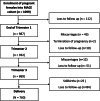Maternal demographic and antenatal factors, low birth weight and preterm birth: findings from the mother and child in the environment (MACE) birth cohort, Durban, South Africa
- PMID: 33076865
- PMCID: PMC7574237
- DOI: 10.1186/s12884-020-03328-6
Maternal demographic and antenatal factors, low birth weight and preterm birth: findings from the mother and child in the environment (MACE) birth cohort, Durban, South Africa
Abstract
Background: Low birthweight (LBW) and preterm birth (PB) remain the leading cause of morbidity and mortality in neonates worldwide. The aim of this study was to identify maternal demographic and antenatal factors associated with PB and LBW among low socio-economic communities.
Methods: Pregnant women (n = 1099) were recruited in the first trimester into the Mother and Child in the Environment (MACE) birth cohort in Durban, South Africa. Maternal factors such as demographic information, health status, residential area, occupational, personal and environmental smoking and biomass fuel use were obtained through standardised interviews, while clinical status was obtained in each trimester and antenatal information on HIV status and treatment, syphilis and conditions such as pregnancy induced hypertension, diabetes etc. was extracted from the antenatal assessments. Key outcomes of interest were preterm birth and low birthweight. The latter data was obtained from the clinical assessments performed by midwives at delivery. Logistic regression models identified factors associated with PB and LBW.
Results: Of the 760 live births, 16.4 and 13.5% were preterm and LBW, respectively. Mothers who delivered by caesarean section had an increased odds of having LBW babies (Adjusted odds ratio (AOR): 1.7; 95% CI: 1.1-2.7) and PB (AOR: 1.7, 95% CI: 1.1-2.7) versus normal vaginal deliveries. Mothers > 30 years (AOR: 1.8, 95% CI: 1.1-2.9) and current smokers (AOR: 2.7, 95% CI: 1.3-5.8) had an increased odds of having PB babies. Compared to younger mothers and non-smokers respectively. An effect of PB and LBW was seen among mothers with high BMI (25.0-29.9 kg/m2) (PB: AOR: 0.5, 95% CI: 0.3-0.9 and LBW: AOR: 0.5, 0.5, CI: 0.3-0.8), and obese BMI (> 30 kg/m2) (PB: AOR: 0.5, 95% CI: 0.3-0.9 and LBW: AOR: 0.4, CI: 0.2-0.7). Maternal HIV (PB AOR: 1.4 and LBW AOR: 1.2) and history of sexually transmitted infections (PB AOR: 2.7 and LBW AOR: 4.2) were not statistically significant.
Conclusion: Maternal age, cigarette smoking and caesarean delivery were associated with LBW and PB. Findings highlight the need of maternal health interventions to improve new-born health outcomes.
Keywords: Age; Caesarean delivery; Cigarette smoking; Low birthweight; Preterm birth.
Conflict of interest statement
The authors declare no competing interests in the conduct of this study.
Figures
Similar articles
-
Low birthweight, preterm births and intrauterine growth retardation in relation to maternal smoking.Paediatr Perinat Epidemiol. 1997 Apr;11(2):140-51. doi: 10.1046/j.1365-3016.1997.d01-17.x. Paediatr Perinat Epidemiol. 1997. PMID: 9131707
-
Incidence and Risk Factors for Low Birthweight and Preterm Birth in Post-Conflict Northern Uganda: A Community-Based Cohort Study.Int J Environ Res Public Health. 2022 Sep 23;19(19):12072. doi: 10.3390/ijerph191912072. Int J Environ Res Public Health. 2022. PMID: 36231374 Free PMC article.
-
Predictors of low birth weight and preterm birth in rural Uganda: Findings from a birth cohort study.PLoS One. 2020 Jul 13;15(7):e0235626. doi: 10.1371/journal.pone.0235626. eCollection 2020. PLoS One. 2020. PMID: 32658895 Free PMC article.
-
Determinants of preterm birth among mothers who gave birth in East Africa: systematic review and meta-analysis.Ital J Pediatr. 2020 Jan 28;46(1):10. doi: 10.1186/s13052-020-0772-1. Ital J Pediatr. 2020. PMID: 31992346 Free PMC article.
-
Association between maternal HIV infection and low birth weight and prematurity: a meta-analysis of cohort studies.BMC Pregnancy Childbirth. 2015 Oct 8;15:246. doi: 10.1186/s12884-015-0684-z. BMC Pregnancy Childbirth. 2015. PMID: 26450602 Free PMC article. Review.
Cited by
-
Impact of ambient air pollution exposure during pregnancy on adverse birth outcomes: generalized structural equation modeling approach.BMC Public Health. 2023 Jan 6;23(1):45. doi: 10.1186/s12889-022-14971-3. BMC Public Health. 2023. PMID: 36609258 Free PMC article.
-
A pilot study: relationship between Bisphenol A, Bisphenol-glucuronide and total 25 hydroxy vitamin D in maternal-child pairs in a South African population.Front Endocrinol (Lausanne). 2024 Nov 28;15:1108969. doi: 10.3389/fendo.2024.1108969. eCollection 2024. Front Endocrinol (Lausanne). 2024. PMID: 39669493 Free PMC article.
-
Subcortical brain volumes in young infants exposed to antenatal maternal depression: Findings from a South African birth cohort.Neuroimage Clin. 2022;36:103206. doi: 10.1016/j.nicl.2022.103206. Epub 2022 Sep 19. Neuroimage Clin. 2022. PMID: 36162238 Free PMC article.
-
Environmental exposures associated with early childhood recurrent wheezing in the mother and child in the environment birth cohort: a time-to-event study.Thorax. 2024 Sep 18;79(10):953-960. doi: 10.1136/thorax-2023-221150. Thorax. 2024. PMID: 38964859 Free PMC article.
-
Educational attainment and offspring birth weight: A bidirectional Mendelian randomization study.Front Genet. 2022 Sep 1;13:922382. doi: 10.3389/fgene.2022.922382. eCollection 2022. Front Genet. 2022. PMID: 36437958 Free PMC article.
References
-
- Dorrington RE, Bradshaw D, Laubscher R, Nannan N. Rapid mortality surveillance report 2017. Cape Town: South African Medical Research Council; 2019.
MeSH terms
Grants and funding
LinkOut - more resources
Full Text Sources
Medical


